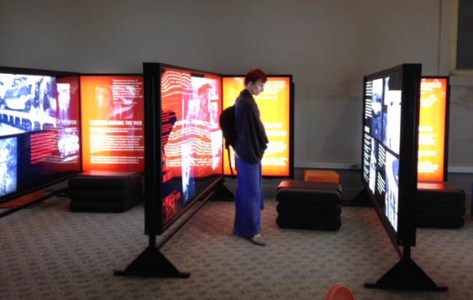Founded in 1970, Visual Communications (VC) was the first nonprofit organization in the country dedicated to supporting the creation, presentation, and preservation of media works by Asian Pacific American people. On the eve of the 31st edition of their Los Angeles Asian Pacific Film Festival, taking place April 23–30, we checked in with Francis Cullado, VC’s Interim Executive Director, and Milton Liu, VC’s Director of Programs and Artist Services, about the state of Asian Pacific American media arts today.

moderator Amy Hill (actor), Randall Park (star), Nahnatchka Khan (showrunner), Melvin Mar (executive producer), and Samie Kim Falvey (Executive Vice President, Comedy Development, ABC). Photo courtesy Visual Communications.
JANM: The world of media arts has changed so much since 1970, and of course, VC has evolved along with it. What would you say are the most significant developments or changes that have occurred at VC in the last 10 years or so?
Francis Cullado: Widespread technological advances have empowered more people to become creative artists. At VC, we’ve developed our programs to utilize new technologies and processes to create digital stories. Gone are the days of expensive media, and with greater accessibility, we can create programs to capture and nurture digital storytellers.
Milton Liu: The media landscape has changed drastically in the last 10 years. Now, you can shoot a film on your iPhone and upload content directly to your YouTube/Vimeo page. Because of this, we’ve seen a surge of content that’s available through non-traditional channels, and a decrease in audiences for movie theaters and appointment television. For this reason, VC continues to focus on diverse year-round programs, such as the Armed with a Camera Fellowship for emerging artists and the Digital Histories program of short films created by senior citizens.
The Conference for Creative Content (C3), the premier entertainment media conference that happens as part of the annual festival, delves into a myriad of traditional and nontraditional topics with leading content creators and executives. For instance, past panels have included Sustaining Your Online Audience, Writing for Diverse Characters in TV, and Transitioning from Film to Video Games. Media continues to evolve and we understand the need for Visual Communications to remain at the forefront of this change.

Photo courtesy Visual Communications.
JANM: APA visibility in the media seems to be growing steadily, getting a big boost recently with the hit TV show, Fresh Off the Boat. What do you think are the important next steps for the community in terms of building and maintaining media presence?
ML: The next steps for the community are to keep pressing to have APAs not only in front of the camera, but behind it. Furthermore, the percentage of APA actors, writers and directors in TV and film still doesn’t come close to matching the percentage of APAs in the American population. Keep fighting to have APAs represented! People of color make up huge audiences that spend our money on film and TV—speak with your wallet!
FC: Keep supporting APAs in media, and keep demanding more! To quote our fellow staffer Abraham Ferrer, for every production highlighting Asian Americans “that crows about diverse casting, there are at least 20 more in which people of color simply don’t exist.” The discourse that Fresh Off the Boat has created and will continue to create has many complexities that revolve around race, ethnicity, and culture, and that’s great. But just because we’ve progressed to a point that is different from where we started, it doesn’t mean that it’s where we want and/or need to be.
For more information about Visual Communications and the upcoming Los Angeles Asian Pacific Film Festival, please visit vconline.org.


























